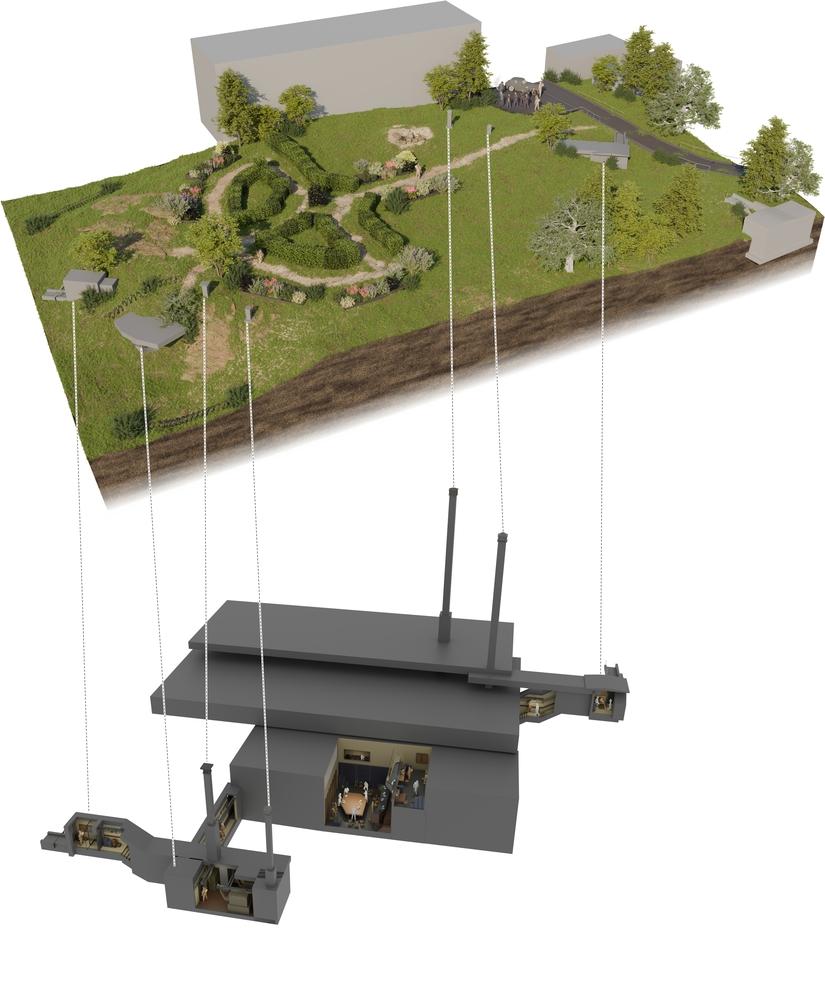New reconstruction reveals the Battle of Britain Bunker's secrets
60 feet (18 metres) below ground level at RAF Uxbridge, lies RAF Fighter Command’s No.11 Group Operations Room, now known as the Battle of Britain Bunker. During the Second World War, this is where the frontline fight against the Luftwaffe (the German air force) during the Battle of Britain was coordinated.
Our new artistic reconstruction shows for the first time how the area above the bunker may have looked during this key period of its history. This is where Winston Churchill is said to have first spoken his famous words, as he was leaving the bunker.
"Never in the field of human conflict was so much owed, by so many, to so few"
Winston Churchill, 16th August 1940
The Battle of Britain
After Germany defeated France in June 1940, their focus turned to their next target – an invasion of Britain. To do this, they had to control the skies. But the British Royal Air Force (RAF) were prepared. Sir Hugh Dowding, Commander-in-Chief of RAF Fighter Command, set up a chain of command centres in bunkers in the south of England. These were able gather intelligence and give the RAF pilots very specific directions of where to fly their famous Supermarine Spitfires and Hawker Hurricane planes to defeat the Germans.
Winston Churchill later wrote about just how important this system of bunkers was, saying:
“All the ascendancy of the Hurricanes and Spitfires would have been fruitless but for this system of underground control centres and telegraph cables”. Churchill, W, The Second World War, Volume 2: Their Finest Hour, (1949), 293-7
Today the bunker is a Grade 1 listed building. This is because of its historical importance. It means that the bunker will be preserved for future generations and special permission must be given for any work which needs to be carried out.
That’s where we come in! Our team of archaeologists have been carrying out a watching brief during recent repair work to parts of the bunker which are above ground. This means that we carefully watched while work was taking place, recording any archaeological remains – including a few WWII bullet casings!
The reconstruction
While the inside of the bunker looks just like it did in 1940, the area above ground, where Churchill’s famous words may have been spoken, looks very different today.
Now, thanks to the recent work, we have been able to create a new artistic reconstruction which reveals forgotten details of the site, including the garden that once camouflaged it.

This ornamental garden was a very clever use of camouflage, and key to the bunker’s survival. Disguised amongst the greenery were a pillbox, gun-emplacement, air vents that provided fresh air to those working underground, as well as entrances to the bunker.
Historic aerial photographs and documentary sources helped us build up our picture of the area above the bunker during WWII. But it was only during our recent archaeological watching brief that our archaeologists discovered some of the tiny details for this reconstruction. These included the iron supports for barbed wire defenses, which showed rolls of barbed wire were used, rather than straight fences.
Our artistic impression of how the bunker may have appeared during WWII has been brought to life with the addition of guards, the men and women of the RAF command, and of course, Winston Churchill himself.
The Battle of Britain Bunker has been preserved for the public as a museum and visitor’s centre. You can find out more about visiting the site by following this link.
You can also read more about the survey work carried out at the bunker in this blog by Historic England.


